Adult substance misuse treatment statistics 2020 to 2021: report
Published 25 November 2021
Applies to England
1. Summary
1.1 Trends in treatment numbers
There were 275,896 adults in contact with drug and alcohol services between April 2020 and March 2021. This is a small rise compared to the previous year (270,705).
The number of adults entering treatment in 2020 to 2021 was 130,490, which is similar to the previous year’s figure (132,124). The number of people entering treatment continues to be relatively stable after falling steadily since 2013 to 2014.
1.2 Trends in substance use treatment
The number of people in treatment for opiate use was very similar to last year (going up slightly from 140,599 to 140,863). Over half (51%) of the adults in treatment were there for problems with opiates, and this remains the largest substance group. Section 2 (People in treatment) has more information about what the different substance groups are.
People in treatment for alcohol alone make up the next largest group (28%) of all adults in treatment. The number of those rose by 3% from the previous year (from 74,618 to 76,740) but this small increase comes after a decline from a peak of 91,651 in 2013 to 2014.
There were increases in the other 2 substance groups (a 9% increase in the non-opiate group and 1% in the non-opiate and alcohol group). This follows a similar small rise last year.
In contrast to previous years, there has been a fall in the number of adults entering treatment for crack cocaine. This includes people who are using crack with opiates (25,043 to 21,308) and those who are using crack without opiates (4,651 to 4,545).
The number of people entering treatment for crack is now at the lowest level since 2016 to 2017.
People starting treatment in 2020 to 2021 with powder cocaine problems decreased by 10% (from 21,396 to 19,209). This ends a rising trend over the last 9 years, which began in 2011 to 2012.
New entrants with cannabis and benzodiazepine problems increased again this year, with a 5% increase in cannabis (from 25,944 in 2019 to 2020 to 27,304 this year) and a 6% increase in benzodiazepines (from 4,083 in 2019 to 2020 to 4,321 this year).
Although the numbers are relatively low, there was an increase in adults entering treatment in 2020 to 2021 with ketamine problems (from 1,140 in 2019 to 2020 to 1,444 this year). This is a 27% rise in one year and is part of a trend in rising numbers entering treatment over the last 7 years. The total is now nearly 3.5 times higher than it was in 2014 to 2015.
1.3 Housing and mental ill health
Over one-sixth (17%, or 22,493) of adults entering treatment last year said they had a housing problem. This proportion varied by substance group, ranging from 1 in 10 (10%, or 4,941) of those starting treatment for alcohol problems alone, to almost a third (30%, or 11,286) of those starting treatment for problems with opiate use. As in previous years, people starting treatment for problems with new psychoactive substances (NPS) had the highest proportion of housing need of any substance group (45%).
Nearly two-thirds (63%, or 82,613) of adults starting treatment said they had a mental health treatment need. This is part of a trend of rising numbers over the previous 2 years (from 53% in 2018 to 2019). Over half of new starters in all substance groups needed mental health treatment. This need ranged from 57% in the opiate group to nearly three-quarters (71%) of the non-opiates and alcohol group.
1.4 Treatment exits and deaths in treatment
There were 110,095 people who exited the drug and alcohol treatment system in 2020 to 2021. Half (50%) of those left having successfully completed their treatment, free from dependence. This is an increase in the proportion of people who successfully completed treatment since the previous year (47%).
The total number of people who died while in contact with treatment services in 2020 to 2021 was 3,726 (1.4% of all adults in treatment). This represents a 27% increase of deaths in treatment compared to last year (2,929, or 1.1% of all adults in treatment).
Last year, all substance groups except opiate users saw a decrease in deaths in treatment compared to the previous year. By contrast, there were increases in the proportion of people dying while in treatment in all substance groups this year. There were increases in the:
- opiate group by 20%
- non-opiate only group by 36%
- non-opiate and alcohol group by 37%
- alcohol only group by 44%
Drug use is a significant cause of premature death in England, as the Office for National Statistics (ONS) drug poisoning data has shown. In England, the number of deaths from drug misuse registered in 2020 was 2,830, the highest level since records began.
1.5 Smoking among people in treatment
Over 51,000 people (56%) said they had smoked tobacco in the 28 days before starting treatment. Across all substance groups, the level of smoking for men and women was substantially higher than the smoking rate of the general adult population (15.9% for men and 12.5% for women).
Despite the high levels of smoking, only 2% of people were recorded as having been offered referrals for smoking cessation interventions. This was down from 3% in 2019 to 2020.
1.6 The effect of the coronavirus (COVID-19) pandemic
Like other services, drug and alcohol treatment services were affected by the need to protect their staff and service users in the pandemic, especially in the early stages. Most services had to restrict face-to-face contact, which affected the types of interventions that service users received. For example, most patients whose opioid substitute consumption was supervised before the pandemic were given take-home doses from March 2020, after a risk assessment. Fewer service users were able to access inpatient detoxification for alcohol and drugs. Testing and treatment for blood-borne viruses and liver disease were also greatly reduced.
These and other changes to service provision during the pandemic may have affected many of the indicators included in this report.
It’s likely that a number of factors will have contributed to the increase in the number of service users who died while in treatment during 2020 to 2021. These include changes to alcohol and drug treatment, reduced access to other healthcare services, changes to lifestyle and social circumstances during lockdowns, and COVID-19 itself.
2. People in treatment: substance, sex, age
2.1 Overview
The National Drug Treatment Monitoring System (NDTMS) statistics report presents information on adults (aged 18 and over) who were receiving help in England for problems with drugs and alcohol in the period between 1 April 2020 and 31 March 2021.
Many people experience difficulties with alcohol and drugs and receive treatment for both substances. While they often share many similarities, they also have clear differences, so this report divides people in treatment into 4 substance groups:
- Opiate: people who are dependent on or have problems with opiates, mainly heroin.
- Non-opiate: people who have problems with non-opiate drugs only, such as cannabis, crack and ecstasy.
- Non-opiate and alcohol: people who have problems with both non-opiate drugs and alcohol.
- Alcohol only: people who have problems with alcohol but do not have problems with any other substances.
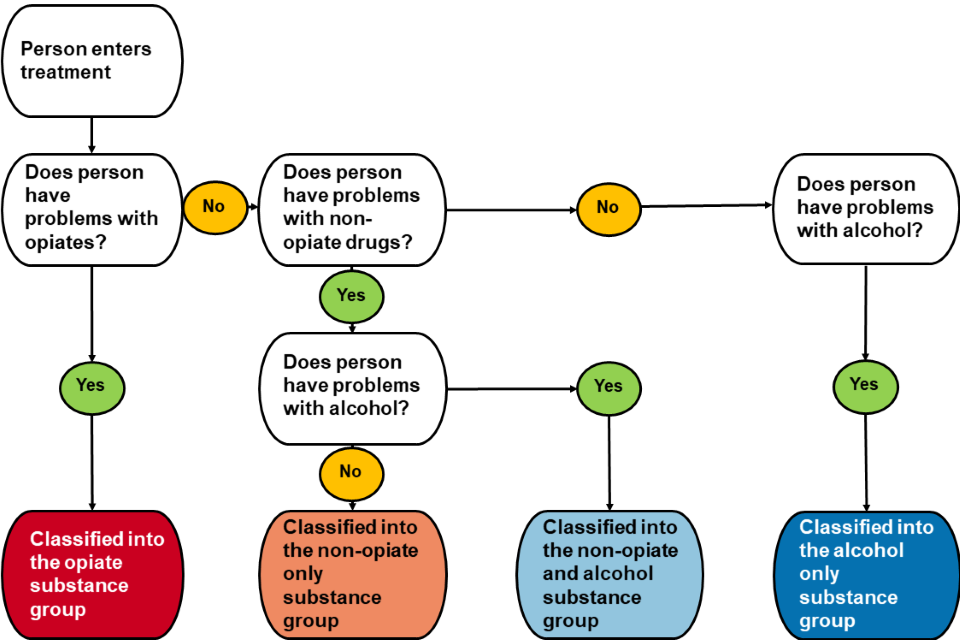
Figure 1: how people are classified into substance reporting groups
See below for a text description of the flowchart showing how people are classified into substance reporting groups after entering treatment and undergoing initial assessment.
People with an opiate problem are placed in the ‘opiate’ substance group regardless of whether other substances are also problematic. For all other individuals, they are categorised as ‘non-opiate only’, ‘non-opiate and alcohol’ or ‘alcohol only’.
Person enters treatment.
Question 1: does the person have problems with opiates?
- Yes: person is classified into the opiate substance group
- No: go to question 2
Question 2: does the person have a problem with non-opiate drugs?
- Yes: go to question 3
- No: go to question 4
Question 3: does the person have problems with alcohol?
- Yes: person is classified into non-opiate and alcohol substance group
- No: person is classified into non-opiate only substance group
Question 4: does the person have problems with alcohol?
- Yes: person is classified into alcohol only substance group
2.2 Substance use, sex and age of people in treatment
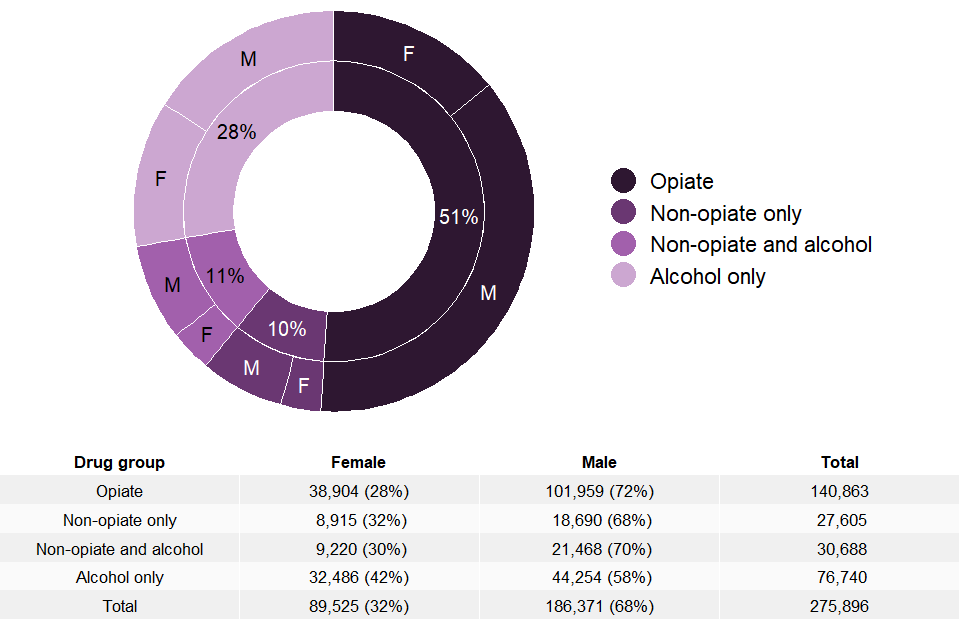
Figure 2: breakdown of people in treatment by sex and substance group
Table 1: people in treatment by sex and substance group
| Substance group | Female | Male | Total |
|---|---|---|---|
| Opiate | 38,904 (28%) | 101,959 (72%) | 140,863 |
| Non-opiate only | 8,915 (32%) | 18,690 (68%) | 27,605 |
| Non-opiate and alcohol | 9,220 (30%) | 21,468 (70%) | 30,688 |
| Alcohol only | 32,486 (42%) | 44,254 (58%) | 76,740 |
| Total | 89,525 (32%) | 186,371 (68%) | 275,896 |
There were 275,896 people in contact with drug and alcohol services between 1 April 2020 and 31 March 2021. Over half of all adults (51%) received treatment for problems with opiates. A further 21% had problems with other drugs, and over a quarter (28%) had problems with alcohol only. These proportions are similar to previous years and you can find more detailed information on trends in chapter 13 (Trends over time).
More than two-thirds of people in treatment were men and less than one-third were women (68% men to 32% women). This proportion varies greatly by substance group. For the drug groupings, men make up over two-thirds (opiate 72%, non-opiate only 68%, non-opiate and alcohol 70%). But in the alcohol only group the divide is smaller with men making up 58% and women 42%.
2.3 Problem substances for people in treatment
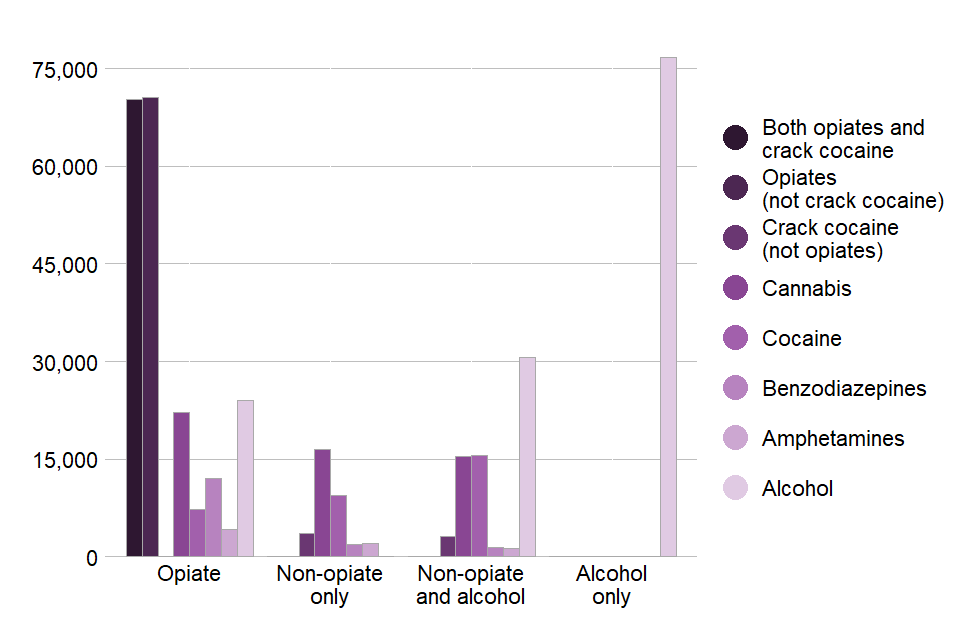
Figure 3: substances by group for people in treatment (count of problem substances reported)
Figure 3 shows a breakdown of the substances reported by people in treatment in 2020 to 2021, split into the 4 treatment groups. Up to 3 substances can be recorded at the start of treatment, so one person could be counted for several substances within their substance group (for example, somebody who uses cocaine, cannabis and alcohol, would appear in the non-opiate and alcohol group for these 3 substances).
The numbers show that opiates were the most frequently reported drug with slightly more people using opiates alone compared to opiates along with crack. Out of all people in treatment, 54% said they had a problem with opiates, crack or both. Almost half (48%) of people said they had problems with alcohol, with most of these being in the alcohol only group. One-fifth (20%) said they used cannabis, most commonly in the opiate substance group. Cocaine was reported by 12% of people, the largest proportion of these being categorised into the non-opiate and alcohol substance group. The next most frequently reported substances were benzodiazepines at 6% and amphetamines (excluding ecstasy) at 3%.
You can find a more detailed breakdown of reported substances in the data tables.
2.4 Age groups
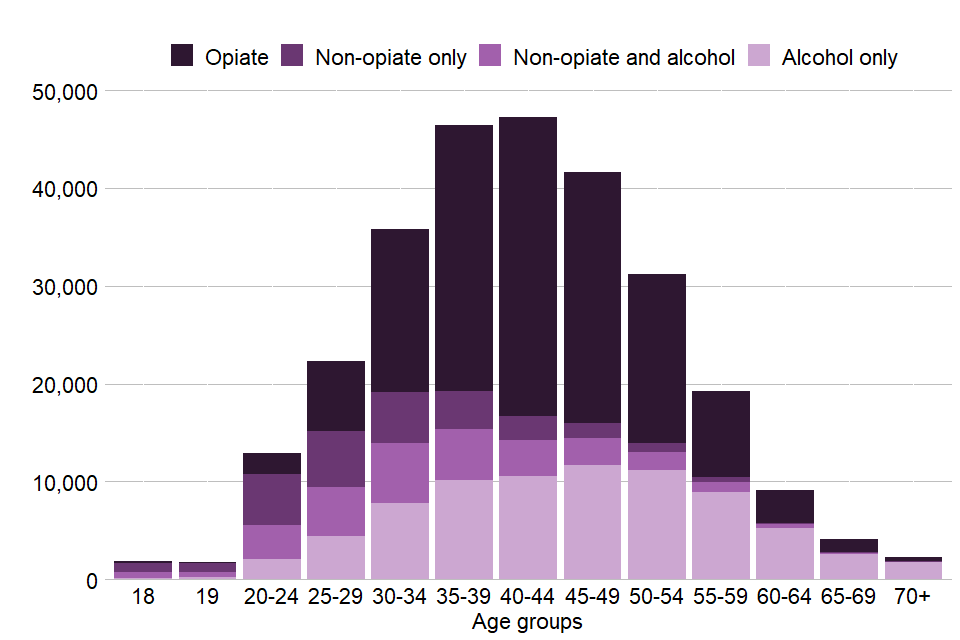
Figure 4: age of people in treatment
Figure 4 shows that the age of people in treatment has continued the trend from previous years showing an increase in older age groups. More than half of the people in treatment (56%) were over 40 years old (compared to 55% in 2019 to 2020 and 51% in 2016 to 2017), with:
- 47,294 people in the 40 to 44 age group
- 41,617 people in the 45 to 49 age group
- 31,172 people in the 50 to 54 age group
- 19,266 people in the 55 to 59 age group
- 15,466 people aged 60 and over
Less than 10% of people in treatment for opiates or alcohol only were under 30 (7% for opiates and 9% for alcohol only). Across all substance groups there were:
- 22,289 people in the 25 to 29 age group
- 12,944 people in the 20 to 24 age group
- 3,615 people aged 18 or 19
The median age of people in treatment in the 4 substance groups ranged from 46 for the alcohol only group to 30 for non-opiates only. People in treatment for opiates had a median age of 42. You can find a detailed breakdown of age statistics in the accompanying data tables.
The distribution of ages of people in treatment is similar to patterns in estimates of prevalence of drug and alcohol use. The latest estimates of opiate and crack use prevalence for 2016 to 2017 show a significant increase in those aged 35 and over who use opiates (130,628 in 2010 to 2011 and 175,452 in 2016 to 2017), reflecting an ageing group.
A large proportion of opiate users in treatment will have started using heroin in the epidemics of the 1980s and 1990s and are now over 40 years old. In 2017 to 2018, 69% said they first used heroin before 2001 and only 9% first used heroin since 2011.
People who reported using substances other than opiates or alcohol tended to be younger. You can find more information about this in the ONS Drug misuse in England and Wales report.
3. Meeting the needs of people who are dependent on alcohol and drugs
The NDTMS treatment figures only show us how many people dependent on alcohol and drugs are in treatment. We can compare this data to prevalence data to get an idea of how people’s needs are met nationally and in each local area.
The main prevalence data we use is:
- estimates of opiate and crack use, produced by Liverpool John Moores University
- estimates of alcohol dependence produced by Sheffield University
3.1 Opiate and crack use
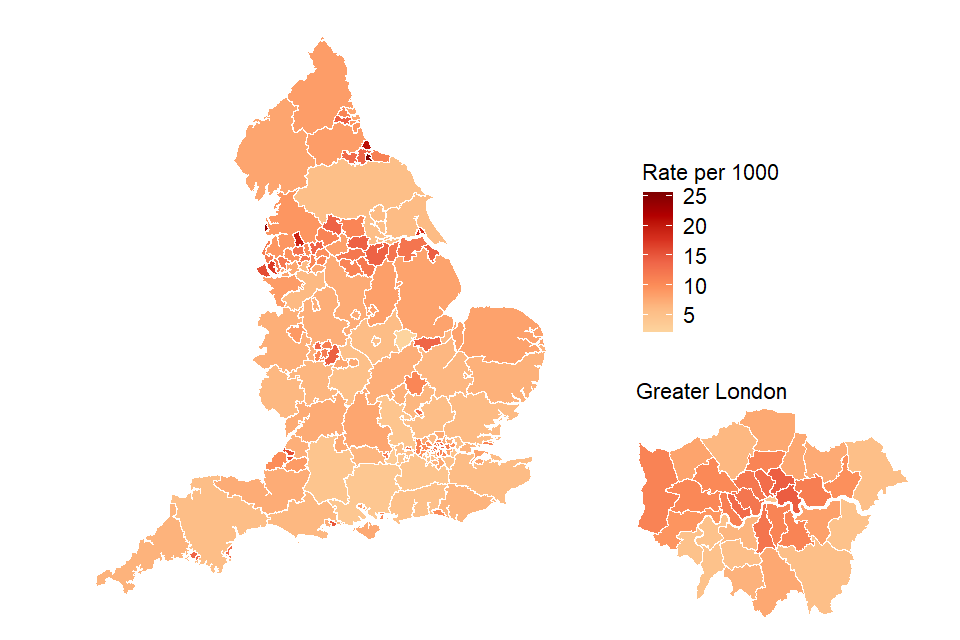
Figure 5: map of opiate and crack use prevalence in 2016 to 2017 by local authority
The opiate and crack use prevalence estimates show that in 2016 to 2017 (the most recent data available) there were an estimated 313,971 people in England aged 15 to 64 who use one or both drugs. This is made up of 261,294 opiate users and 180,748 crack cocaine users.
Nearly two-thirds of these people are between 35 and 64 years old. The proportion of estimated opiate users who are not in treatment has continued to rise from 40.8% in 2014 to 2015 to 46.7% in 2019 to 2020. The proportion of crack users who are not in treatment is 58.0%.
Figure 5 shows how levels of opiate and crack use vary across England. Prevalence rates ranged from 2 people per thousand of the population in Rutland in the East Midlands to 26 people per thousand in Middlesbrough. Many of the highest prevalence rates are in the north of England. In London, the highest prevalence rates tend to be in the inner boroughs such as Tower Hamlets and Hackney, and the lowest rates are in the outer boroughs like Bexley, Kingston upon Thames and Richmond upon Thames.
Opiate and crack use are also strongly linked to deprivation. We saw 56% of people in treatment for crack and/or opiates living in areas ranked in the 30% most deprived areas in England.
Public Health England (PHE) published the latest opiate and crack prevalence estimates for each local authority in England.
You can also see how local areas compare on the numbers of opiate users and dependent drinkers who are not in treatment in the Public Health Dashboard.
3.2 Alcohol dependence
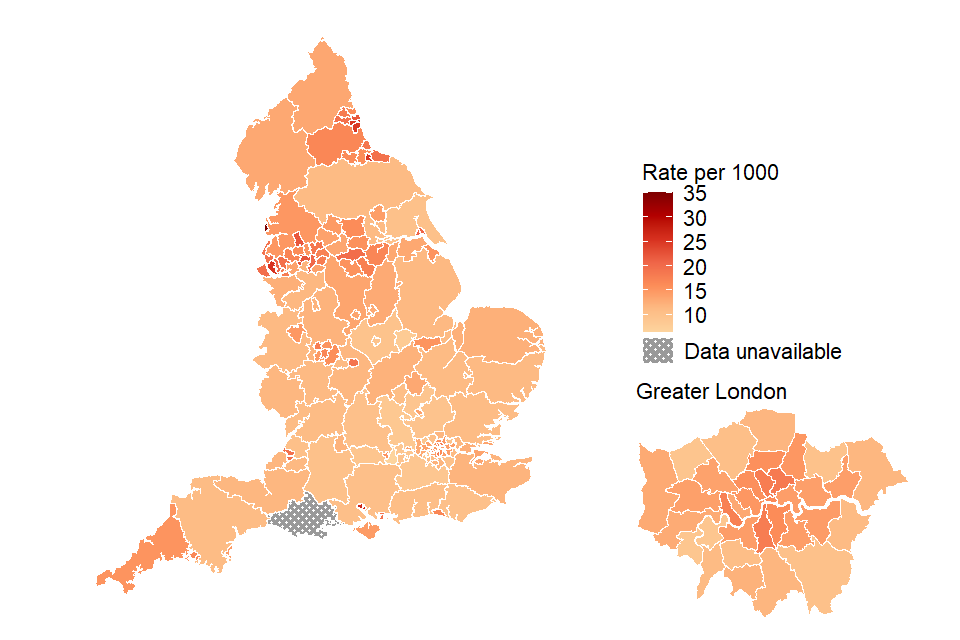
Figure 6: map of alcohol dependence prevalence in 2018 to 2019 by local authority
There were an estimated 602,391 adults with alcohol dependency in need of specialist treatment in 2018 to 2019 (the most recent figures available). This is a rise of 2.6% from the previous year and is the first time these estimates have risen since 2015 to 2016.
There were 107,428 people in treatment for alcohol in 2020 to 2021 (the total of alcohol only plus the non-opiate and alcohol groups). So, based on these estimates, there was an estimated 82% of adults in need of specialist treatment for alcohol who were not receiving it.
Figure 6 shows how levels of alcohol dependence vary across England. Like the opiate and crack prevalence rates, the higher prevalence rates are concentrated in the north of England. Rates ranged from 6 per 1000 in Wokingham in the South East to 35 per 1000 in Blackpool. In London, alcohol dependence again followed the same pattern as opiate and crack prevalence. The highest rates tended to be in the inner boroughs such as Islington and Hackney, and the lowest rates were in outer boroughs like Redbridge and Richmond upon Thames. PHE published the latest prevalence estimates for alcohol dependence for each local authority in England.
You can also see how local areas compare on the numbers of dependent drinkers who are not in treatment on the Public Health Dashboard.
4. People starting treatment: substances, age and referral source
4.1 Substances reported by people starting treatment

Figure 7: substances by group for people starting treatment in 2020 to 2021 (count of problem substances reported)
In 2020 to 2021, 130,490 people started treatment for drug and alcohol problems. This is where a person started a new treatment journey, either for the first time or returning to treatment having had a break of over 21 days.
Of the people starting treatment:
- 60% said they had a problem with alcohol
- 29% said they had a problem with opiates
- 20% said they had a problem with crack cocaine
- 21% said they had a problem with cannabis
- 15% said they had a problem with cocaine
Also, of the people who said they had a problem with alcohol, 60% (52,220) said it was their only problem substance.
Figure 7 shows the number of people starting treatment who reported problems with each substance, divided into the 4 substance groups. Most people with alcohol problems were in the alcohol only group. However, alcohol was the most frequently reported substance in the non-opiate and alcohol group, and the third most frequently reported substance in the opiate group.
In the non-opiate and alcohol group, cocaine was the second most frequently reported drug, followed closely by cannabis. Cannabis was the most frequently reported drug in the non-opiate substance group, followed by cocaine. The numbers show that most people in the opiates group used both opiates and crack. Opiates without crack was the second most commonly reported substance in this group.
People starting treatment with cannabis and benzodiazepine problems increased again this year, with a 5% increase in cannabis (from 25,944 in 2019 to 2020 to 27,304 this year) and a 6% increase in benzodiazepines (from 4,083 in 2019 to 2020 to 4,321 this year).
Although the numbers are relatively low, there was an increase in adults entering treatment in 2020 to 2021 with ketamine problems (from 1,140 in 2019 to 2020 to 1,444 this year). There was also a small rise in methamphetamine treatment numbers this year (from 467 last year to 505), which has been increasing gradually since reporting began in 2005 to 2006.
You can find more information on the breakdown of club drugs by substance group in the accompanying data tables.
4.2 Age of people starting treatment
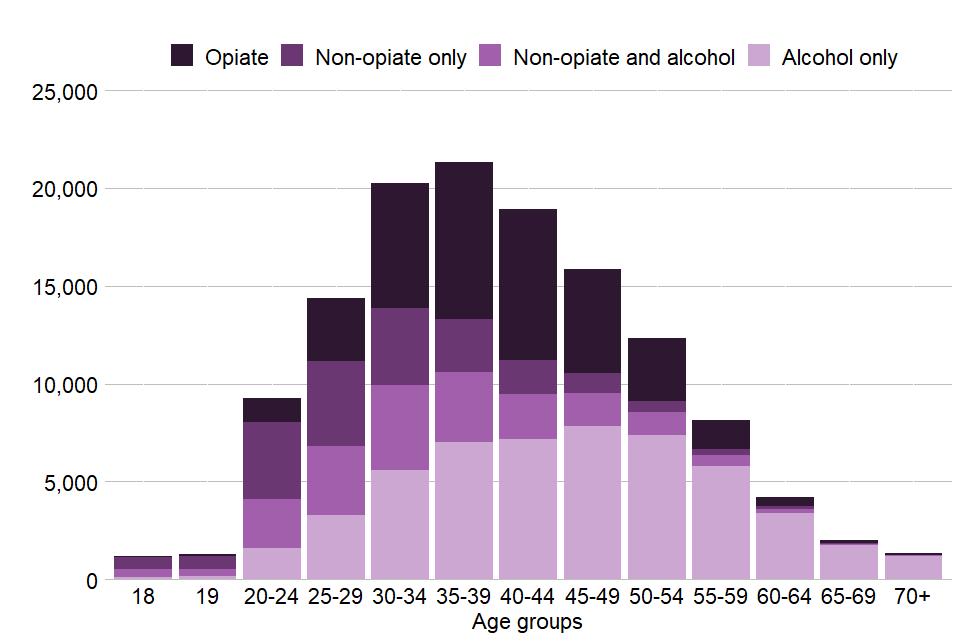
Figure 8: people starting treatment by age
Figure 8 shows the number of people starting treatment in each age group, categorised into the 4 substance groups. The most common age group was 35 to 39, with 21,305 people starting treatment. This was followed by the 30 to 34 age group, with 20,259 people, then the 40 to 44 age group with 18,916 people. Within these 3 groups, the opiate substance group was the largest. Nearly half of people starting treatment (48%) were 40 years and over. Of those aged 55 years and over, 86% said they had problems with alcohol only. This is an increase of 9% compared to the previous year.
The non-opiate only and non-opiate and alcohol groups had the largest proportion of people under 30 years old starting treatment, at 46% and 33% respectively.
4.3 Referral sources

Figure 9: referral sources for people starting treatment in 2020 to 2021
Of the people starting treatment in 2020 to 2021, 61% self-referred (which could have been following advice from a healthcare professional) or were referred by family and friends. This was the most common referral source in all 4 substance groups.
Referral from healthcare was the second most common referral source and made up 15% overall. This includes referrals from GPs, which accounted for 6% of all referrals, but was higher in the alcohol only group at 8%. Hospitals made up 4% of all referrals while only 3% of referrals came from social services. Referrals from healthcare varied between the individual substance groups. Only 8% of opiate referrals came from healthcare compared to 21% of alcohol only referrals.
Collectively, referrals from the criminal justice system made up 12%. But there was a big difference between substance groups, with 23% of opiate referrals coming from the criminal justice system compared to just 6% for those with only alcohol problems. Prison referrals accounted for 5% of all referrals. You can find a further breakdown of these groups in the accompanying data tables.
5. Housing
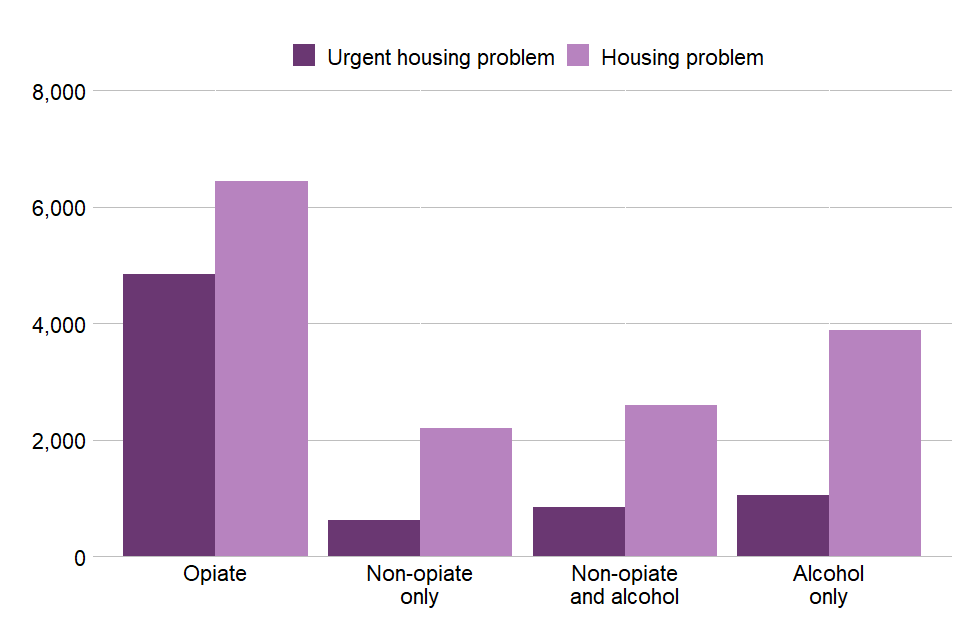
Figure 10: housing need for people starting treatment in 2020 to 2021
Around 1 in 9 people (12%) starting treatment said they had a housing problem and a further 6% had an urgent problem. For people with opiate problems, the proportion with a housing problem was 17% and an additional 13% had an urgent housing problem.
Figure 10 shows the numbers of people starting treatment who had a housing problem or an urgent housing problem, separated into the 4 substance groups. The opiate substance group had the highest number with 11,286 people saying they had a housing problem or an urgent housing problem. The alcohol only group had the second highest numbers with 3,886 people saying they had a housing problem and 1,055 people saying they had an urgent housing problem.
The people in treatment with NPS problems had the highest proportion of housing need, with 45% saying they had a housing problem (urgent or otherwise) when starting treatment.
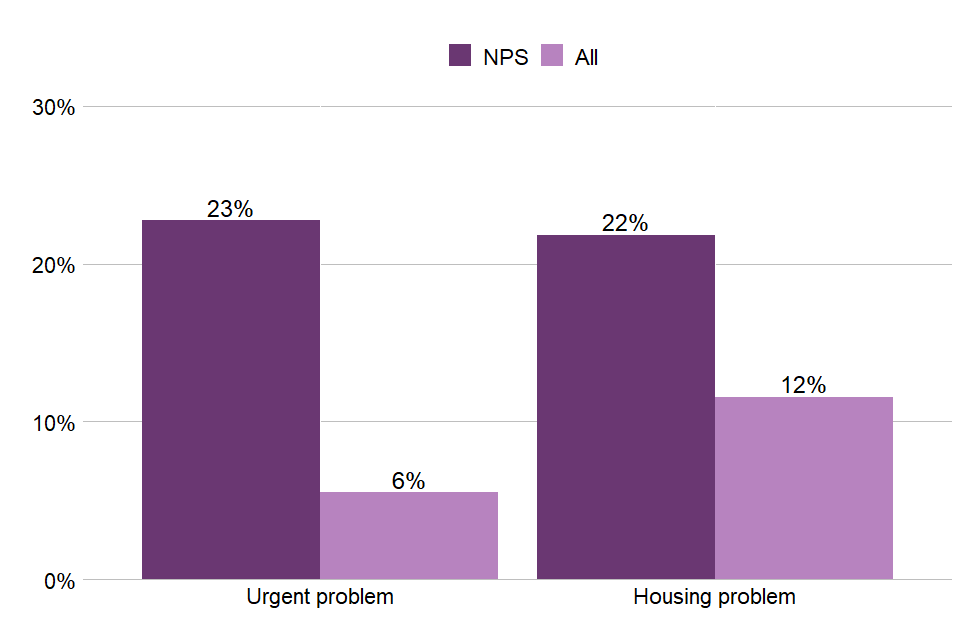
Figure 11: housing need for people with problems with new psychoactive substances starting treatment in 2020 to 2021
Figure 11 shows the proportion of people with NPS problems who reported housing problems, compared to the proportion of all people starting treatment. It shows that 23% of people with NPS problems said they had an urgent housing problem compared to 6% of all people starting treatment. For non-urgent housing problems, the proportions were 22% of people with NPS problems and 12% for all people starting treatment.
6. Mental health

Figure 12: mental health need and treatment received for people starting treatment in 2020 to 2021
Nearly two-thirds of people starting treatment said they had a mental health need (63%). When looking at the 4 substance groups, the proportions of people reporting a mental health need were:
- 57% of people in the opiates group
- 64% of people in the non-opiate only group
- 64% of people in the alcohol only group
- 71% of people in the non-opiate and alcohol group
A quarter (25%) of people who had a mental health need were not receiving any treatment to meet this need. Of those receiving mental health treatment, over half (55%) received it in a primary care setting, such as a GP surgery.
7. Injecting status
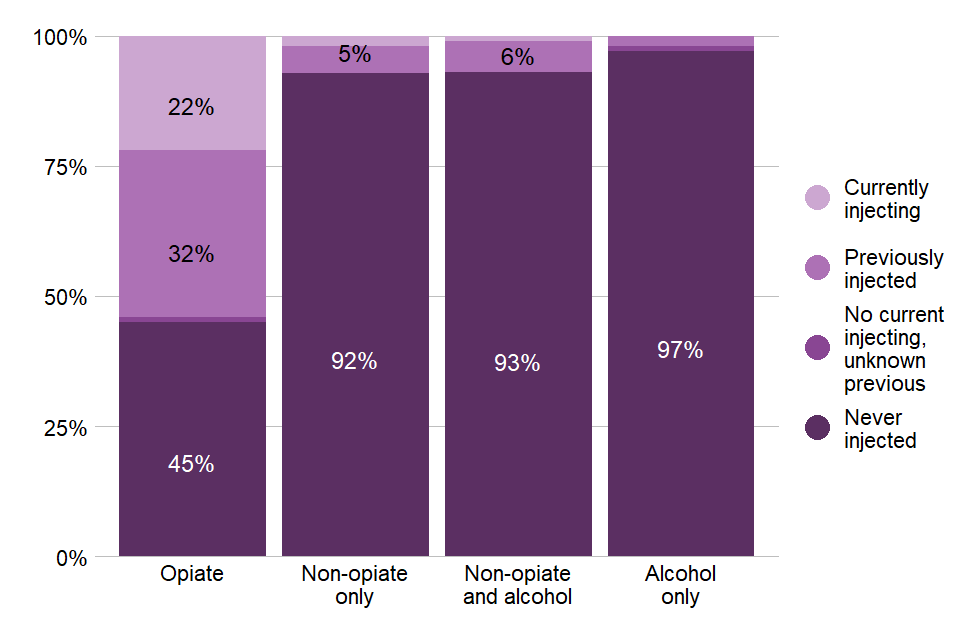
Figure 13: injecting status of people starting treatment in 2020 to 2021
Nineteen percent of all people starting treatment were currently injecting or had previously injected drugs. This is much higher for people with opiate problems, with 22% currently injecting and 32% having previously injected. In the other 3 substance groups, over 90% of people had never injected drugs. In the non-opiate only and non-opiate and alcohol groups, 5% and 6% said they had previously injected, respectively. Only very small numbers outside of the opiate substance group were currently injecting with just 2% of people in the non-opiate only group, and 1% of the non-opiate and alcohol group. Only 2% of people with alcohol only problems had previously injected drugs.
This year, injecting status also includes data from outcomes, so there is an additional category for people not currently injecting but whose injecting history was not known. These people accounted for less than 1% of those starting treatment.
8. Parental status and safeguarding children
8.1 Parental status
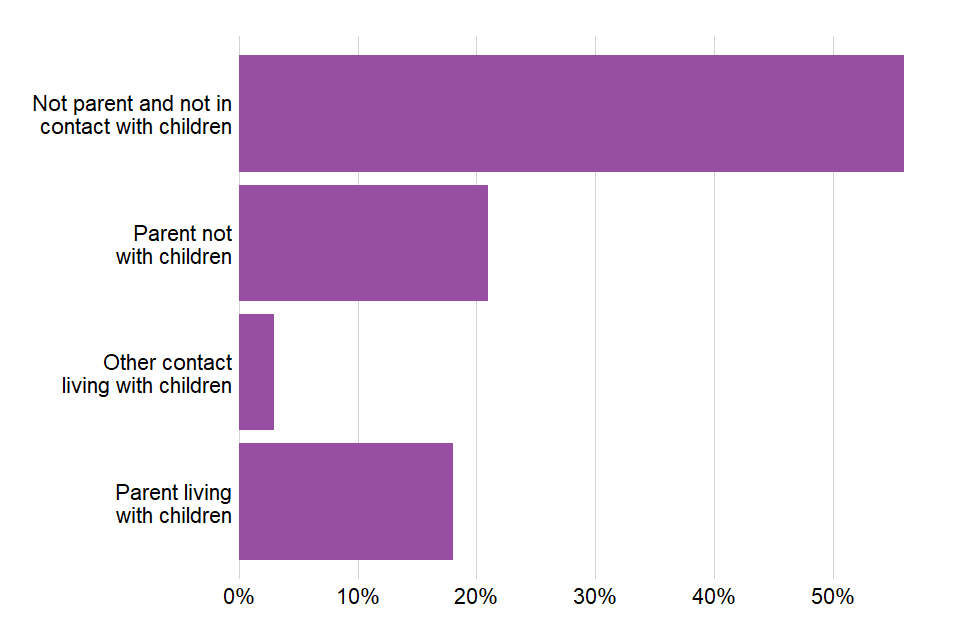
Figure 14: parental status of people starting treatment in 2020 to 2021
In 2020 to 2021, 21% (27,208) of people starting treatment were living with children, either their own or someone else’s. A further 21% were parents who were not living with their children. This was highest among women in treatment for opiates, where 28% were parents who were not living with their children.
Twenty-nine percent of women reported either living with a child, or being a parent when they started treatment, compared to 17% of men.
The average number of children per household where people in treatment live with a child was 1.9.
The total number of children of people starting treatment was 51,328. This includes children who:
- live with parents in treatment
- have parents in treatment that they do not live with
- are living with someone in treatment who is not their parent
Seventy percent of these children were receiving no early help. In contrast, 12% of the children of all people starting treatment had a child protection plan and this figure was highest in the non-opiate group, at 20%.

Figure 15: children receiving early help or in contact with children's social care
9. Smoking
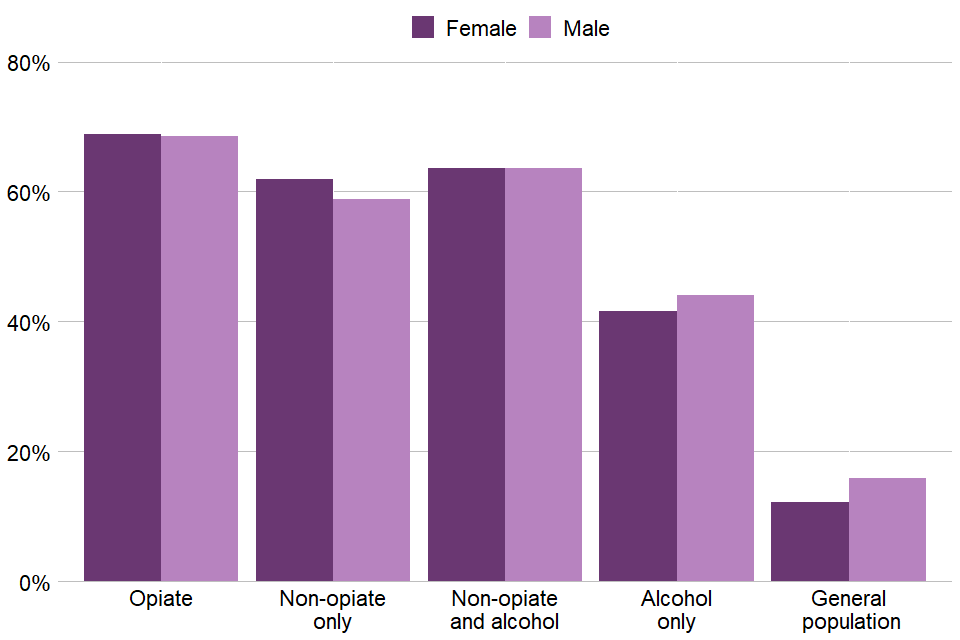
Figure 16: smoking rates at the start of treatment
Over 51,000 people (56%) said they had smoked tobacco in the 28 days before starting treatment. This is based on information collected at the start of treatment and a 6 month review using the treatment outcomes profile, published by PHE as part of a set of outcome monitoring forms.
Across all substance groups, men and women reported smoking at similar levels. And in all cases, the level of smoking was substantially higher than the smoking rate of the general adult population (15.9% for men and 12.5% for women).
Despite the high levels of smoking, only 2% of people were recorded as having been offered referrals for smoking cessation interventions.
10. Treatment interventions

Figure 17: breakdown of settings where peoples’ treatment took place
Note: we have excluded settings with proportions of less than 1% from this figure, but the information is available in the accompanying data tables.
Almost all (99%) people in treatment received some form of structured treatment. You can find a definition of structured treatment in the NDTMS business definitions guidance.
Of the people that did receive structured treatment:
- 98% received a community-based treatment
- 7% received treatment in a primary care setting
- 3% received treatment in an inpatient setting
- 1% received treatment in a residential setting
The number of people receiving treatment in inpatient and residential settings has continued to fall. In 2020 to 2021, there were 13,214 people in those settings, down from 15,161 in the previous year, a 13% drop. This year’s figure is 49% lower than 2014 to 2015 (25,847).
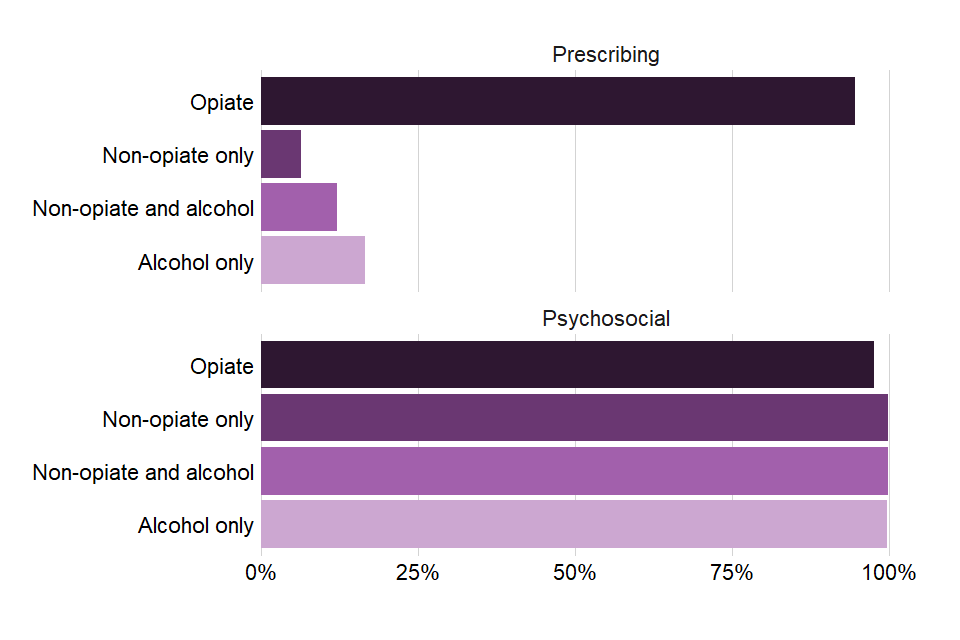
Figure 18: breakdown of type of treatment that people received
Figure 18 shows the breakdown of the main type of intervention received, either prescribing or psychosocial interventions, by people in treatment for the four main substance groups.
Ninety-nine percent of people received a psychosocial intervention while 55% received at least one prescribing intervention.
Over 99% of people in the non-opiate only, non-opiate and alcohol, and alcohol only groups received a psychosocial intervention. People with problems with opiates had the lowest proportion of people receiving a psychosocial intervention, with 98%.
Of those who received a prescribing intervention:
- 95% were in the opiate group
- 17% were in the alcohol only group
- 12% were in the non-opiate group
- 6% were in the non-opiate only group
Of the people starting treatment, 98% did so within 3 weeks of being referred to treatment.
11. Treatment outcomes
11.1 Treatment exits and successful completion of treatment

Figure 19: breakdown of latest treatment exits in 2020 to 2021
A total of 110,095 people left drug and alcohol treatment in 2020 to 2021.
Of the people who left treatment, 50% completed their treatment successfully and were discharged as ‘treatment completed’. The alcohol only group had the highest rate of treatment completed at 62%. This was closely followed by the non-opiate group (57%) and the non-opiate and alcohol group (55%). The opiate only group had a rate of 25%.
A third (33%) of people left treatment without completing it, while 12% left either due to unsuccessful transfers between services or the person declining further treatment.
On average, people who completed treatment successfully did so within a year of starting treatment (283 days). The average time in treatment for people with opiate problems was around 2.5 years (930 days) and around 6 months for the other substance groups (164 days for non-opiate only, 201 days for non-opiate and alcohol and 197 days for alcohol only).
11.2 Deaths in treatment
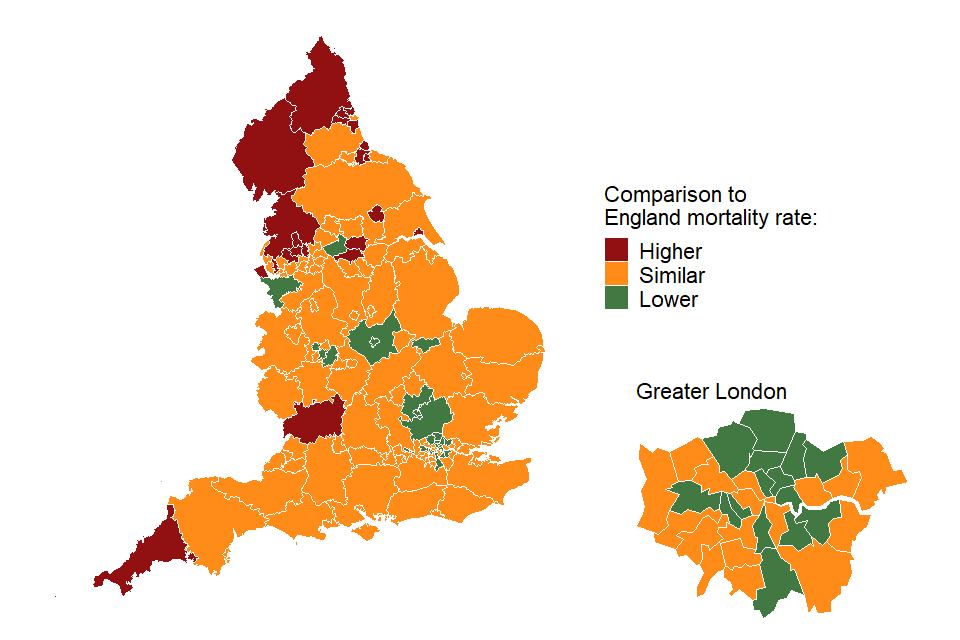
Figure 20: map of deaths in drug treatment (mortality ratio between 2018 to 2019 and 2020 to 2021)
Every year, people die while they are in an alcohol and drug treatment programme, but these deaths might not be alcohol or drug related.
Figure 20 is a map showing the local authorities where the number of deaths of people in drug and alcohol treatment are higher or lower than, or similar to the number of deaths in treatment we would see in that local authority if the mortality rate was the same as England overall. This data includes deaths in treatment between April 2018 and March 2021. Figures used in this map were calculated as indirectly age-standardised ratios for each local authority and are available in the data tables that accompany this report.
Ratios greater than 1.0 show a higher mortality rate than the overall mortality rate for England and ratios lower than 1.0 show a lower mortality rate. The higher mortality ratios are concentrated in the north west and north east of England. Ratios ranged from 0.2 in Redbridge to 2.0 in Gateshead. In London, higher ratios tended to be in the inner boroughs such as Camden and Southwark, and the lower ratios were in outer boroughs like Redbridge and Waltham Forest.
Mortality ratio data for each local authority can also be found on the Public Health Dashboard.
There were 3,726 recorded deaths in treatment in 2020 to 2021, which represented 1.4% of all people in treatment. People with opiate problems accounted for nearly two-thirds (65%) of these deaths, and the alcohol only group a further 29%.
Over a third (34%) of deaths among opiate users were people living in the most deprived 10% of areas in England. In the non-opiate treatment group, there was a similar proportion, with 31% of people who died in treatment living in these most deprived areas.
Data from the ONS shows that rates of drug misuse deaths continue to be higher among people born in the 1970s, with the highest rate in those aged 45 to 49. Among men, there were 109.7 drug poisoning deaths registered per million in 2020 (3,108 registered deaths), compared with 49.8 deaths per million among women (1,453 deaths).
11.3 Self-reported outcomes: substance use
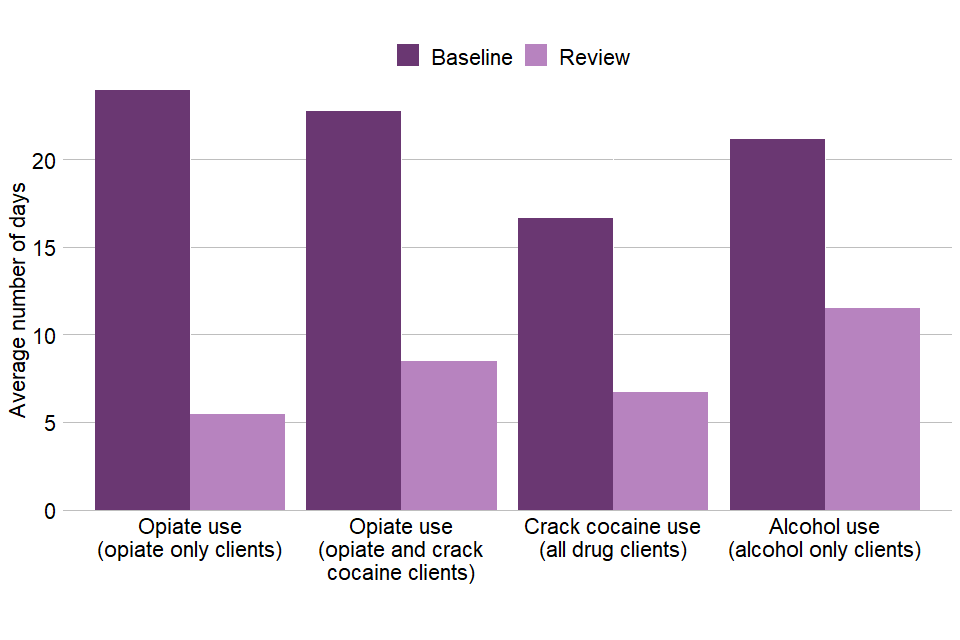
Figure 21: change in self-reported number of days use between start of treatment and 6 month review
The Office for Health Improvement and Disparities (OHID) collects information about the outcomes for people who use drug and alcohol treatment services. This includes the treatment outcomes profile, which measures change and progress in important areas of their lives.
People with opiate problems reported a fall in the average number of days they used opiates in the last 28 days, from 23.2 at the start of treatment to 7.3 after 6 months of treatment.
The alcohol only group reported a fall in the number of days that they used alcohol in the last 28 days before their 6 month review, from 21.2 to 11.5.
12. Self-reported outcomes: education, employment and injecting

Figure 22: change in self-reported injecting, employment and education between start of treatment and 6 month review
For people in education at the start treatment and at their 6 month review, the average number of days that they reported being in education rose from 11.2 at the start to 11.3 at the review.
For people in employment at the start of treatment and at their 6 month review, the average number of days they were in employment in the last 28 days increased. This rose from 17.6 days at the start of treatment to 17.7 days at their review.
For people with opiate problems who were injecting at the start of treatment, the average number of days of injecting dropped from 20.9 days per month at the start of treatment to 6.1 days per month at the 6 month review.
13. Trends over time
13.1 Numbers in treatment
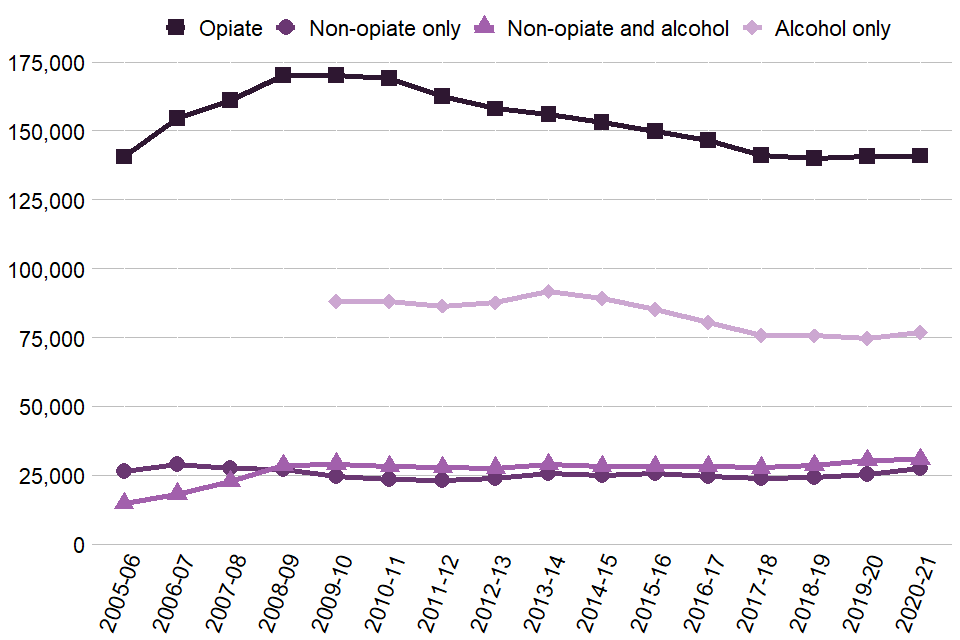
Figure 23: trends in numbers in treatment by substance group between 2005 to 2006 and 2020 to 2021
The overall number of people in treatment increased by 2% since last year, with 275,896 people in treatment, the highest amount since 2016 to 2017.
The non-opiate group saw the highest number of people (27,605) in treatment since 2006 to 2007 (28,777). The non-opiate and alcohol group continued an upward trend from 27,684 in 2017 to 2018, to 30,688 this year, an 11% increase. The opiate group and alcohol only group have remained stable since 2017 to 2018 with a 0.2% decrease and 1% increase respectively.
Numbers for people in treatment who said they had a problem with alcohol only are shown from 2009 to 2010 onwards when national alcohol treatment data collection started.
These trends over time can be found on NDTMS.net using the ViewIt tool. You can choose to display either England or local authority level data, as well as split the data by substance, sex and age groups.
13.2 People leaving treatment
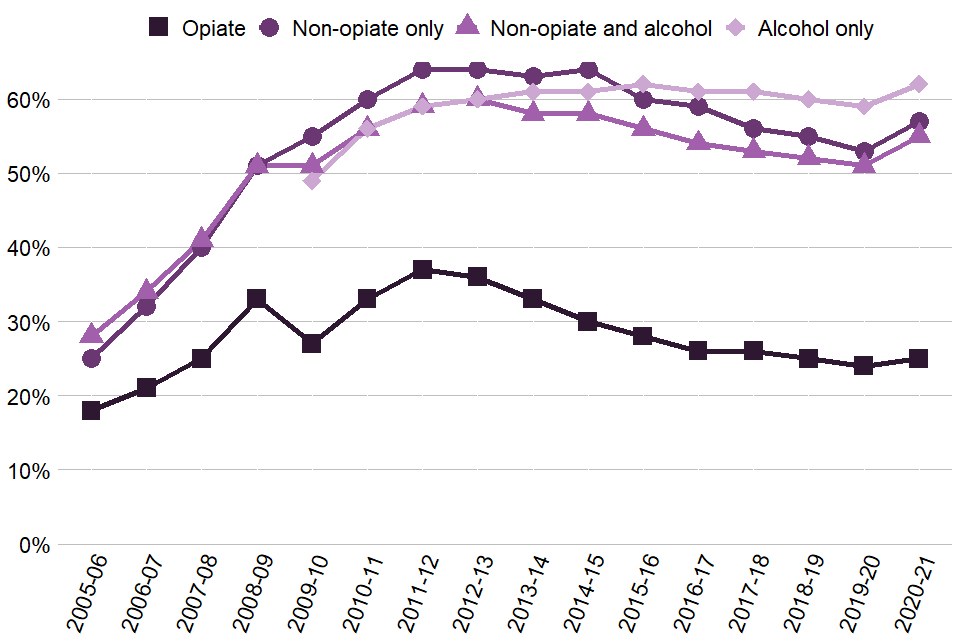
Figure 24: trends in people successfully completing treatment as a proportion of exits in the year between 2005 to 2006 and 2020 to 2021
The percentage of people leaving treatment free of dependence rose in 2020 to 2021 to 50.4%. This is the highest proportion since 2015 to 2016 (50.5%). For the first time since 2011 to 2012 there were increases in each group’s successful completion rate. The increases were most pronounced in the non-opiate (3.6% increase) and non-opiate and alcohol groups (4.0% increase). The alcohol only group had its highest proportion of people leaving treatment free of dependence (62%) on record.
13.3 Trends in substance use

Figure 25: trends of people starting treatment with opiate and/or crack problems between 2005 to 2006 and 2020 to 2021
The number of people entering treatment for problems with opiates but not crack continued on a downward trend that started in 2009 to 2010. It has decreased by 52% over the last 11 years.
The number of people entering treatment for both crack and opiates dropped by 15% this year, and it is now at 21,308, which is the lowest number since 2015 to 2016. The number of people entering treatment for crack without opiates has been stable since 2018 to 2019 but has increased 58% since the lowest point in 2014 to 2015. The number in treatment for crack without opiates (6,794) has remained stable compared with the previous year but is higher than in the previous 10 years.
The number of people starting treatment for NPS (1,283 this year) has remained stable since 2017 to 2018 (1,223).
The number of people with ecstasy problems continued to fall, with 693 people starting treatment this year compared to a high of 2,399 in 2007 to 2008.
There was a continued rise in ketamine numbers, with 1,444 people coming to treatment, compared to 426 in 2014 to 2015. The number of people with methamphetamine problems also rose to 505, compared to 131 in 2011 to 2012.
You can find more detailed data on the drugs people had problems with in the accompanying data tables.
13.4 Deaths in treatment

Figure 26: trends in deaths of people in treatment between 2005 to 2006 and 2020 to 2021
In 2020 to 2021, the proportion of deaths of people in treatment increased from 1.1% to 1.4%. This is the largest increase in the proportion of people dying in treatment since NDTMS data has been collected. This trend has increased from 711 deaths in 2005 to 2006 to 3,726 deaths in 2019 to 2020, which is more than a 5 fold increase.
13.5 Deaths in treatment by substance
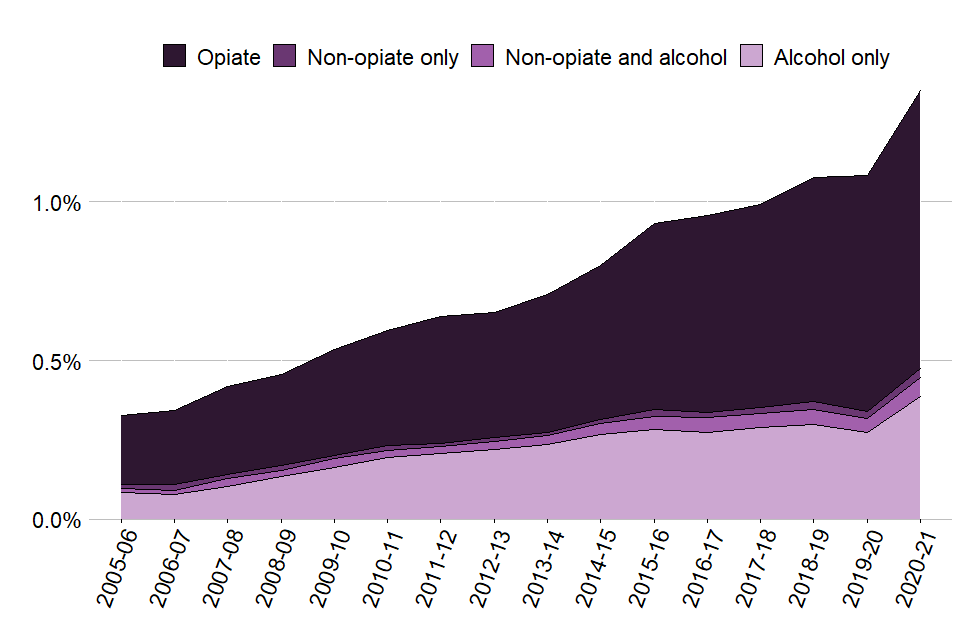
Figure 27: percentages of deaths in treatment between 2005 to 2006 and 2020 to 2021
This year, the proportion of deaths in treatment increased in all substance groups. There were increases in the:
- opiate group from 1.4% to 1.7%
- non-opiate only group from 0.2% to 0.3%
- non-opiate and alcohol group from 0.4% to 0.6%
- alcohol only group from 1.0% to 1.4%
14. A 16-year analysis
14.1 People in treatment

Figure 28: last status of all people in treatment between 2005 to 2006 and 2020 to 2021
In the 16 years of treatment data starting from 2005 to 2006, there has been a total of 1,057,687 people in contact with drug and alcohol treatment services. By 31 March 2021:
- 155,860 (15%) were still engaged in treatment
- 413,538 (39%) had left before they completed their treatment and had not returned
- 488,289 (46%) had completed their treatment and not returned
14.2 Treatment journeys
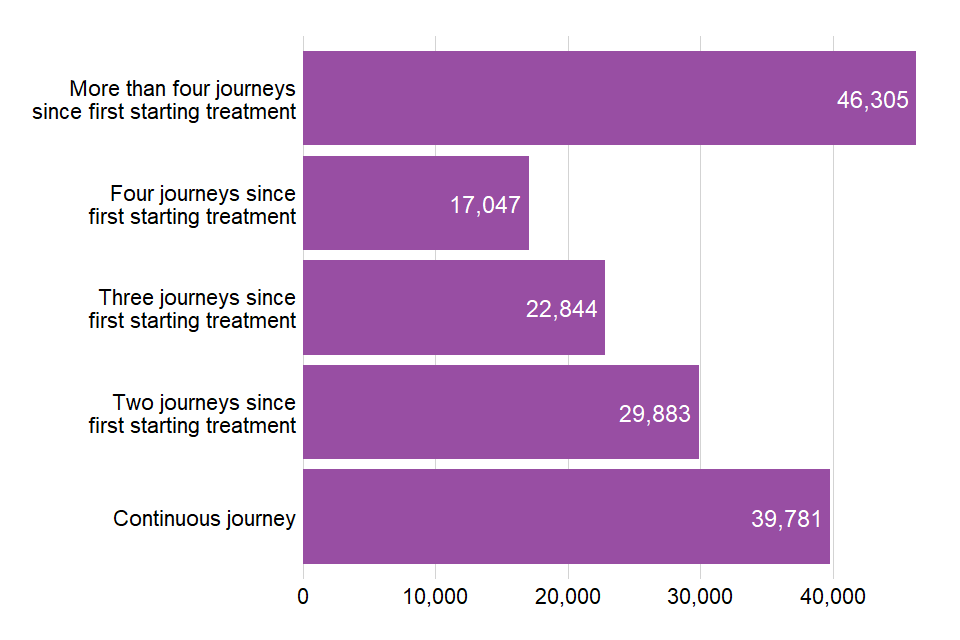
Figure 29: number of previous journeys for people still in treatment at the end of 2020 to 2021
Of the people still in treatment at the end of March 2021, well over a third (41%) have had 4 or more treatment journeys. Over a quarter (26%) have been in treatment continuously since their treatment started, 50% of those people started treatment in 2020 to 2021, and 31% have been in treatment for 5 years or more
You can find more information on the methodology of this analysis in the NDTMS annual statistics quality and methodology document.
15. Background and policy context
15.1 Background to the data
This report presents statistics on the availability and effectiveness of alcohol and drug treatment in England and the profile of people accessing this treatment.
The statistics in this publication come from analysis of the NDTMS. The NDTMS collects data from about 600 sites providing structured alcohol and drug treatment interventions, covering every local authority in England.
Treatment centres returning data include:
- community-based drug and alcohol services
- specialist outpatient services
- GP surgeries
- residential rehabilitation centres
- inpatient units
The data collected includes information on the demographics and personal circumstances of people receiving treatment, as well as details of the interventions delivered and their outcomes.
You can find more details on the methodology used in the report in the NDTMS annual statistics quality and methodology document.
Alcohol and drug treatment statistics reports for previous years can be found in the OHID Alcohol and drug misuse and treatment statistics collection.
15.2 Policy context
Alcohol and drug treatment in England is commissioned by local authorities using the public health grant. They are responsible for assessing local need for treatment and commissioning a range of services and interventions to meet that need.
The public health grant conditions make it clear that:
A local authority must, in using the grant, have regard to the need to improve the take up of, and outcomes from, its drug and alcohol misuse treatment services based on an assessment of local need and a plan which has been developed with local health and criminal justice partners.
OHID works with local authorities and provides them with bespoke data, guidance, tools and other support to help them commission services more effectively.
Guidance for alcohol and drug treatment is available in the Alcohol and drug misuse prevention and treatment guidance collection.
A wide range of NDTMS data is available at the NDTMS website, including some data reports that are only available to local authority commissioners (via login).
In July 2021, the Department of Health and Social Care published the second part of a major independent review by Professor Dame Carol Black into the misuse of illegal drugs in England.
The report contains 32 recommendations for change across various government departments and other organisations, to improve the effectiveness of drug prevention and treatment and to help more people recover from dependence.
OHID is working with other government departments and stakeholders to implement the review’s recommendations.
